Details
Location
Contributions
Displaying 571 - 580 of 2403Building a common vision for sustainable food and agriculture
Over the coming 35 years, agriculture will face an unprecedented confluence of pressures, including a 30 percent increase in the global population, intensifying competition for increasingly scarce land, water and energy resources, and the existential threat of climate change. To provide for a population projected to reach 9.3 billion in 2050 and support changing dietary patterns, estimates are that food production will need to increase from the current 8.4 billion tonnes to almost 13.5 billion tonnes a year.
SDG Indicator 2.4.1: Percentage of Agricultural Area under Productive and Sustainable Agriculture
There has been considerable discussion over the past thirty years on how to define “sustainable agriculture.” During most of this period, sustainability was exclusively considered an environmental issue and was therefore measured as such. The 2030 Agenda requires that all sectors, including agriculture, be considered from the point of view of the three dimensions of sustainability: economic, social and environmental.
SDG Goal 11: Monitoring Framework
In September 2015, the United Nations Sustainable Development Summit adopted a new framework to guide development efforts between 2015 and 2030, entitled “Transforming our world: the 2030 Agenda for sustainable development”.1
Government of the Italian Republic
Politics of Italy is conducted through a Parliamentary Republic with a multi-party system. Italy has been a democratic republic since 2 June 1946, when the
ICLEI Seoul Declaration
On this day 9 April 2015, in Seoul, the capital of the Republic of Korea, on the occasion of the ICLEI World Congress 2015, ICLEI Members and representatives of local, subnational governments and our partners worldwide, proclaim the ICLEI Seoul Declaration.
The New Urban Agenda
The New Urban Agenda represents a shared vision for a better and more sustainable future – one in which all people have equal rights and access to the benefits and opportunities that cities can offer, and in which the international community reconsiders the urban systems and physical form of our urban spaces to achieve this.
Framework and Guiding Principles for a Land Degradation Indicator
Framework and Guiding Principles for a Land Degradation Indicator to monitor and report on progress towards target 15.3 of the Sustainable Development Goals, the strategic objectives of the Rio Conventions and other relevant targets and commitments
SDG Indicator 15.3.1 - Proportion of land that is degraded over total land area
Presentation by Sasha Alexander from the UNCCD about SDG Indicator 15.3.1 about the proportion of land that is degraded over total land area.
SDG indicator 15.3.1: Proportion of land that is degraded over total land area
The UNCCD is the custodian agency leading an Inter-Agency Advisory Group on 15.3.1 composed of our key partner FAO as well as the CBD, UNFCCC, UNEP and UNSD to further refine the methodology and data tools/options for this indicator.
United Nations Sustainable Development Solutions Network
The UN Sustainable Development Solutions Network (SDSN) has been operating since 2012 under the auspices of the UN Secretary-General. SDSN mobilizes global scientific and technological expertise to promote practical solutions for sustainable development, including the implementation of the Sustainable Development Goals (SDGs) and the Paris Climate Agreement.











